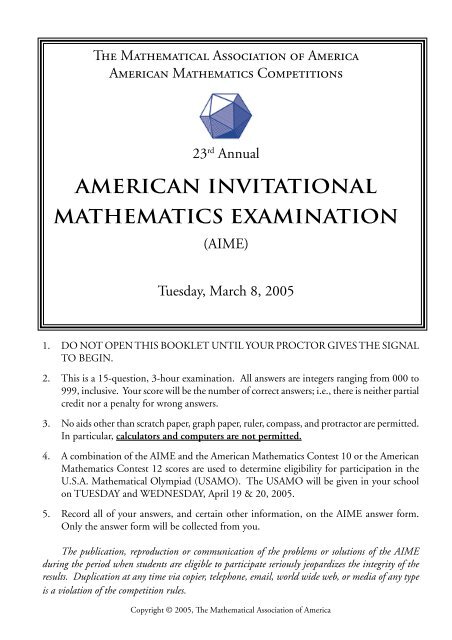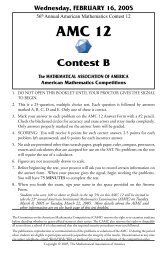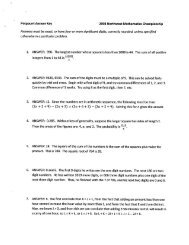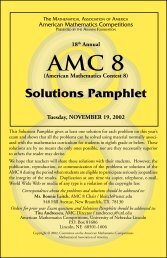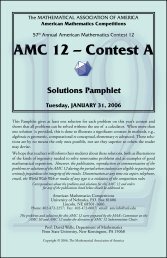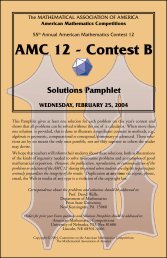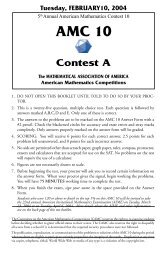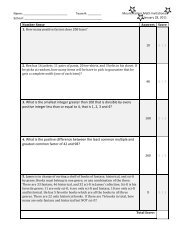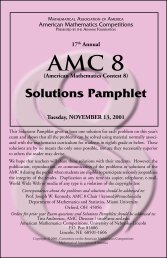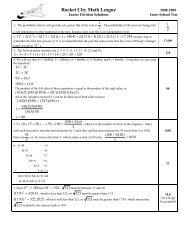AMERICAN INVITATIONAL MATHEMATICS EXAMINATION
AMERICAN INVITATIONAL MATHEMATICS EXAMINATION
AMERICAN INVITATIONAL MATHEMATICS EXAMINATION
Create successful ePaper yourself
Turn your PDF publications into a flip-book with our unique Google optimized e-Paper software.
The Mathematical Association of America<br />
American Mathematics Competitions<br />
23 rd Annual<br />
<strong>AMERICAN</strong> <strong>INVITATIONAL</strong><br />
<strong>MATHEMATICS</strong> <strong>EXAMINATION</strong><br />
(AIME)<br />
Tuesday, March 8, 2005<br />
1. DO NOT OPEN THIS BOOKLET UNTIL YOUR PROCTOR GIVES THE SIGNAL<br />
TO BEGIN.<br />
2. This is a 15-question, 3-hour examination. All answers are integers ranging from 000 to<br />
999, inclusive. Your score will be the number of correct answers; i.e., there is neither partial<br />
credit nor a penalty for wrong answers.<br />
3. No aids other than scratch paper, graph paper, ruler, compass, and protractor are permitted.<br />
In particular, calculators and computers are not permitted.<br />
4. A combination of the AIME and the American Mathematics Contest 10 or the American<br />
Mathematics Contest 12 scores are used to determine eligibility for participation in the<br />
U.S.A. Mathematical Olympiad (USAMO). The USAMO will be given in your school<br />
on TUESDAY and WEDNESDAY, April 19 & 20, 2005.<br />
5. Record all of your answers, and certain other information, on the AIME answer form.<br />
Only the answer form will be collected from you.<br />
The publication, reproduction or communication of the problems or solutions of the AIME<br />
during the period when students are eligible to participate seriously jeopardizes the integrity of the<br />
results. Duplication at any time via copier, telephone, email, world wide web, or media of any type<br />
is a violation of the competition rules.<br />
Copyright © 2005, The Mathematical Association of America
2005 AIME 2<br />
1. Six congruent circles form a ring with each circle externally tangent to the two<br />
circles adjacent to it. All six circles are internally tangent to a circle C with<br />
radius 30. Let K be the area of the region inside C and outside all of the six<br />
circles in the ring. Find ⌊K⌋. (The notation ⌊K⌋ denotes the greatest integer<br />
that is less than or equal to K.)<br />
2. For each positive integer k, let S k denote the increasing arithmetic sequence of<br />
integers whose first term is 1 and whose common difference is k. For example,<br />
S 3 is the sequence 1, 4, 7, . . .. For how many values of k does S k contain the<br />
term 2005<br />
3. How many positive integers have exactly three proper divisors, each of which<br />
is less than 50 (A proper divisor of a positive integer n is a positive integer<br />
divisor of n other than n itself.)<br />
4. The director of a marching band wishes to place the members into a formation<br />
that includes all of them and has no unfilled positions. If they are arranged in<br />
a square formation, there are 5 members left over. The director finds that if<br />
they are arranged in a rectangular formation with 7 more rows than columns,<br />
the desired result can be obtained. Find the maximum number of members this<br />
band can have.<br />
5. Robert has 4 indistinguishable gold coins and 4 indistinguishable silver coins.<br />
Each coin has an engraving of a face on one side, but not on the other. He wants<br />
to stack the eight coins on a table into a single stack so that no two adjacent<br />
coins are face to face. Find the number of possible distinguishable arrangements<br />
of the 8 coins.<br />
6. Let P be the product of the nonreal roots of x 4 − 4x 3 + 6x 2 − 4x = 2005. Find<br />
⌊P ⌋. (The notation ⌊P ⌋ denotes the greatest integer that is less than or equal<br />
to P .)<br />
7. In quadrilateral ABCD, BC = 8, CD = 12, AD = 10, and m̸ A = m̸ B = 60 ◦ .<br />
Given that AB = p + √ q, where p and q are positive integers, find p + q.
8. The equation<br />
2005 AIME 3<br />
2 333x−2 + 2 111x+2 = 2 222x+1 + 1<br />
has three real roots. Given that their sum is m/n, where m and n are relatively<br />
prime positive integers, find m + n.<br />
9. Twenty-seven unit cubes are each painted orange on a set of four faces so that<br />
the two unpainted faces share an edge. The 27 cubes are then randomly arranged<br />
to form a 3 × 3 × 3 cube. Given that the probability that the entire surface of<br />
the larger cube is<br />
p a<br />
orange is<br />
q b , where p, q, and r are distinct primes and a, b, and c are positive<br />
rc integers,<br />
find a + b + c + p + q + r.<br />
10. Triangle ABC lies in the Cartesian plane and has area 70. The coordinates<br />
of B and C are (12, 19) and (23, 20), respectively, and the coordinates of A are<br />
(p, q). The line containing the median to side BC has slope −5. Find the largest<br />
possible value of p + q.<br />
11. A semicircle with diameter d is contained in a square whose sides have length<br />
8. Given that the maximum value of d is m − √ n, where m and n are integers,<br />
find m + n.<br />
12. For positive integers n, let τ(n) denote the number of positive integer divisors<br />
of n, including 1 and n. For example, τ(1) = 1 and τ(6) = 4. Define S(n) by<br />
S(n) = τ(1) + τ(2) + · · · + τ(n).<br />
Let a denote the number of positive integers n ≤ 2005 with S(n) odd, and let b<br />
denote the number of positive integers n ≤ 2005 with S(n) even. Find |a − b|.<br />
13. A particle moves in the Cartesian plane from one lattice point to another according<br />
to the following rules:<br />
• From any lattice point (a, b), the particle may move only to (a+1, b), (a, b+1),<br />
or (a + 1, b + 1).<br />
• There are no right angle turns in the particle’s path. That is, the sequence of<br />
points visited contains neither a subsequence of the form (a, b), (a + 1, b), (a +<br />
1, b + 1) nor a subsequence of the form (a, b), (a, b + 1), (a + 1, b + 1).<br />
How many different paths can the particle take from (0, 0) to (5, 5)
2005 AIME 4<br />
14. Consider the points A(0, 12), B(10, 9), C(8, 0), and D(−4, 7). There is a unique<br />
square S such that each of the four points is on a different side of S. Let K be<br />
the area of S. Find the remainder when 10K is divided by 1000.<br />
15. In △ABC, AB = 20. The incircle of the triangle divides the median containing<br />
C into three segments of equal length. Given that the area of △ABC is m √ n,<br />
where m and n are integers and n is not divisible by the square of any prime,<br />
find m + n.
Your Exam Manager will receive a copy of the 2005 AIME Solution Pamphlet with the scores.<br />
CONTACT US -- Correspondence about the problems and solutions for this AIME and orders for any of<br />
the publications listed below should be addressed to:<br />
American Mathematics Competitions<br />
University of Nebraska, P.O. Box 81606<br />
Lincoln, NE 68501-1606<br />
Phone: 402-472-2257; Fax: 402-472-6087; email: amcinfo@unl.edu<br />
The problems and solutions for this AIME were prepared by the MAA’s Committee on the AIME under the<br />
direction of:<br />
David Hankin, AIME Chair<br />
207 Corbin Place, Brooklyn, NY 11235 USA<br />
2005 USAMO -- THE USA MATHEMATICAL OLYMPIAD (USAMO)<br />
is a 6-question, 9-hour, essay-type examination. The USAMO will be held in<br />
your school on Tuesday, April 19 & Wednesday, April 20. Your teacher has more<br />
details on who qualifies for the USAMO in the AMC 10/12 and AIME Teachers’<br />
Manuals. The best way to prepare for the USAMO is to study previous years of<br />
these exams, the World Olympiad Problems/Solutions and review the contents<br />
of the Arbelos. Copies may be ordered from the web sites indicated below.<br />
PUBLICATIONS -- For a complete listing of available publications please visit the following<br />
web sites:<br />
AMC - - http://www.unl.edu/amc/d-publication/publication.html<br />
MAA -- https://enterprise.maa.org/ecomtpro/timssnet/common/tnt_frontpage.cfm<br />
The<br />
American Invitational Mathematics Examination (AIME)<br />
and the<br />
American Mathematics Competitions<br />
are Sponsored by<br />
The Mathematical Association of America –– MAA ...........................www.maa.org/<br />
University of Nebraska – Lincoln –– UN-L ..................................... www.unl.edu/<br />
Contributors<br />
The Akamai Foundation – ..................................................................... www.akamai.com/<br />
American Mathematical Association of Two Year Colleges – AMATYC....................... www.amatyc.org/<br />
American Mathematical Society –– AMS.................................................... www.ams.org/<br />
American Society of Pension Actuaries –– ASPA....................................... www.aspa.org/<br />
American Statistical Association –– ASA............................................... www.amstat.org/<br />
Art of Problem Solving –– ................................................ www.artofproblemsolving.com/<br />
Canada/USA Mathpath –– C/USA MP ................................................www.mathpath.org/<br />
Canada/USA Mathcamp –– C/USA MC ............................................ www.mathcamp.org/<br />
Casualty Actuarial Society –– CAS........................................................... www.casact.org/<br />
Clay Mathematics Institute –– CMI...................................................... www.claymath.org/<br />
Institute for Operations Research and the Management Sciences –– INFORMS............. www.informs.org/<br />
L. G. Balfour Company ..........................................................................www.balfour.com/<br />
Mu Alpha Theta –– MAT.............................................................. www.mualphatheta.org/<br />
National Council of Teachers of Mathematics –– NCTM........................... www.nctm.org/<br />
Pedagoguery Software Inc. –– .................................................................. www.peda.com/<br />
Pi Mu Epsilon –– PME....................................................................... www.pme-math.org/<br />
Society of Actuaries –– SOA........................................................................ www.soa.org/<br />
U. S. A. Math Talent Search –– USAMTS................................................. www.usamts.org/<br />
W. H. Freeman and Company ........................................................www. whfreeman.com/


